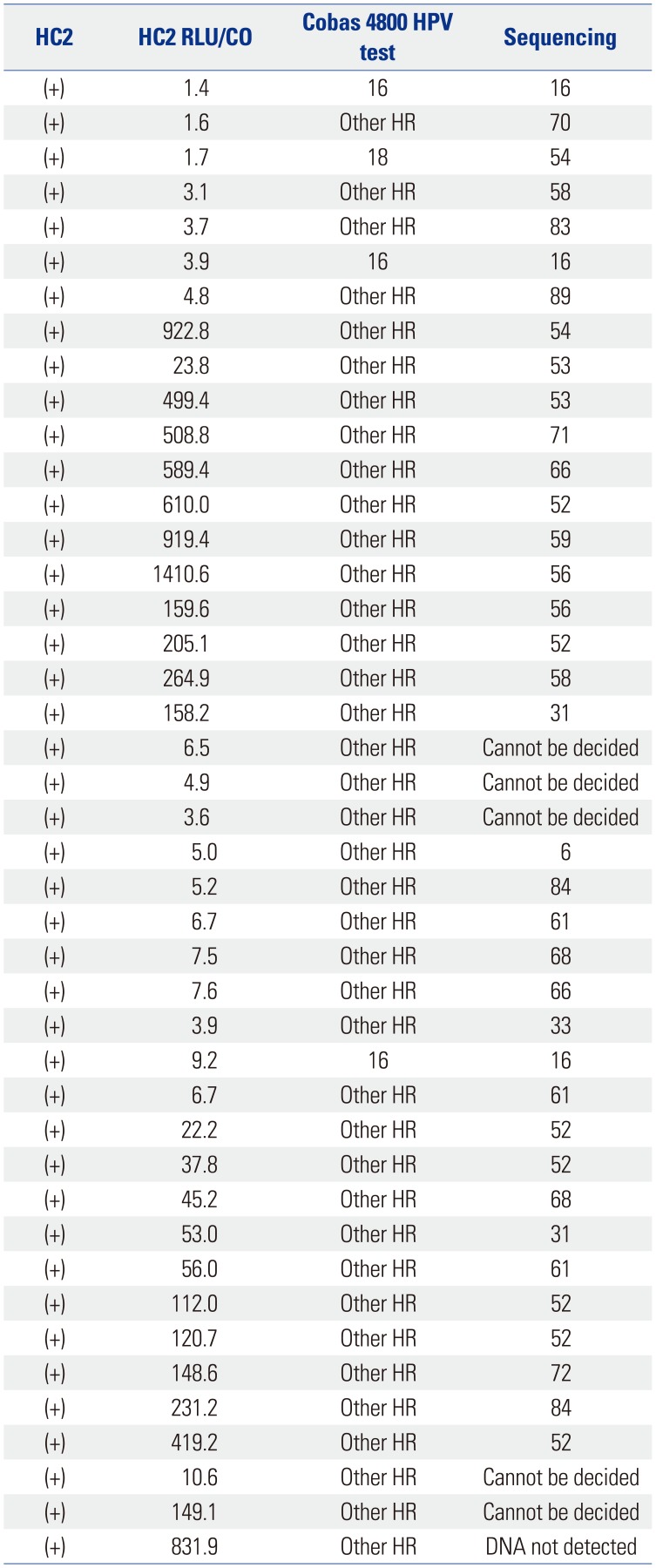1. Ferlay J, Shin HR, Bray F, Forman D, Mathers C, Parkin DM. Estimates of worldwide burden of cancer in 2008: GLOBOCAN 2008. Int J Cancer. 2010; 127:2893–2917. PMID:
21351269.

2. Jung KW, Won YJ, Kong HJ, Oh CM, Cho H, Lee DH, et al. Cancer statistics in Korea: incidence, mortality, survival, and prevalence in 2012. Cancer Res Treat. 2015; 47:127–141. PMID:
25761484.

3. Jung KW, Won YJ, Oh CM, Kong HJ, Cho H, Lee DH, et al. Prediction of cancer incidence and mortality in Korea, 2015. Cancer Res Treat. 2015; 47:142–148. PMID:
25779360.

4. Seol HJ, Ki KD, Lee JM. Epidemiologic characteristics of cervical cancer in Korean women. J Gynecol Oncol. 2014; 25:70–74. PMID:
24459584.

5. Walboomers JM, Jacobs MV, Manos MM, Bosch FX, Kummer JA, Shah KV, et al. Human papillomavirus is a necessary cause of invasive cervical cancer worldwide. J Pathol. 1999; 189:12–19. PMID:
10451482.

6. So KA, Kim MJ, Lee KH, Lee IH, Kim MK, Lee YK, et al. The impact of high-risk HPV genotypes other than HPV 16/18 on the natural course of abnormal cervical cytology: a Korean HPV Cohort Study. Cancer Res Treat. 2016; 48:1313–1320. PMID:
26987394.

7. Ki EY, Kim HE, Choi YJ, Park JS, Kang CS, Lee A. Comparison of the Cobas 4800 HPV test and the Seeplex HPV4A ACE with the hybrid capture 2 test. Int J Med Sci. 2013; 10:119–123. PMID:
23329882.

8. Agorastos T, Chatzistamatiou K, Katsamagkas T, Koliopoulos G, Daponte A, Constantinidis T, et al. Primary screening for cervical cancer based on high-risk human papillomavirus (HPV) detection and HPV 16 and HPV 18 genotyping, in comparison to cytology. PLoS One. 2015; 10:e0119755. PMID:
25793281.

9. Saslow D, Solomon D, Lawson HW, Killackey M, Kulasingam SL, Cain J, et al. American Cancer Society, American Society for Colposcopy and Cervical Pathology, and American Society for Clinical Pathology screening guidelines for the prevention and early detection of cervical cancer. Am J Clin Pathol. 2012; 137:516–542. PMID:
22431528.

10. Castle PE, Sadorra M, Lau T, Aldrich C, Garcia FA, Kornegay J. Evaluation of a prototype real-time PCR assay for carcinogenic human papillomavirus (HPV) detection and simultaneous HPV genotype 16 (HPV16) and HPV18 genotyping. J Clin Microbiol. 2009; 47:3344–3347. PMID:
19675214.

11. Kovacic MB, Castle PE, Herrero R, Schiffman M, Sherman ME, Wacholder S, et al. Relationships of human papillomavirus type, qualitative viral load, and age with cytologic abnormality. Cancer Res. 2006; 66:10112–10119. PMID:
17047075.

12. Min KJ, So KA, Lee J, Hong HR, Hong JH, Lee JK, et al. Comparison of the Seeplex HPV4A ACE and the Cervista HPV assays for the detection of HPV in hybrid capture 2 positive media. J Gynecol Oncol. 2012; 23:5–10. PMID:
22355460.

13. Wong AA, Fuller J, Pabbaraju K, Wong S, Zahariadis G. Comparison of the hybrid capture 2 and cobas 4800 tests for detection of high-risk human papillomavirus in specimens collected in PreservCyt medium. J Clin Microbiol. 2012; 50:25–29. PMID:
22090403.

14. Castle PE, Stoler MH, Wright TC Jr, Sharma A, Wright TL, Behrens CM. Performance of carcinogenic human papillomavirus (HPV) testing and HPV16 or HPV18 genotyping for cervical cancer screening of women aged 25 years and older: a subanalysis of the ATHENA study. Lancet Oncol. 2011; 12:880–890. PMID:
21865084.

15. Lindemann ML, Dominguez MJ, de Antonio JC, Sandri MT, Tricca A, Sideri M, et al. Analytical comparison of the cobas HPV Test with Hybrid Capture 2 for the detection of high-risk HPV genotypes. J Mol Diagn. 2012; 14:65–70. PMID:
22079749.
16. Schiffman M, Castle PE, Jeronimo J, Rodriguez AC, Wacholder S. Human papillomavirus and cervical cancer. Lancet. 2007; 370:890–907. PMID:
17826171.

17. Yeo MK, Lee A, Hur SY, Park JS. Clinical significance of an HPV DNA chip test with emphasis on HPV-16 and/or HPV-18 detection in Korean gynecological patients. J Pathol Transl Med. 2016; 50:294–299. PMID:
27345180.

18. Sung YE, Ki EY, Lee YS, Hur SY, Lee A, Park JS. Can human papillomavirus (HPV) genotyping classify non-16/18 high-risk HPV infection by risk stratification? J Gynecol Oncol. 2016; 27:e56. PMID:
27550402.

19. So KA, Hong JH, Lee JK. Human papillomavirus prevalence and type distribution among 968 women in South Korea. J Cancer Prev. 2016; 21:104–109. PMID:
27390739.

20. Stoler MH, Wright TC Jr, Sharma A, Apple R, Gutekunst K, Wright TL. ATHENA HPV Study Group. High-risk human papillomavirus testing in women with ASC-US cytology: results from the ATHENA HPV study. Am J Clin Pathol. 2011; 135:468–475. PMID:
21350104.

21. Park Y, Lee E, Choi J, Jeong S, Kim HS. Comparison of the Abbott RealTime High-Risk Human Papillomavirus (HPV), Roche Cobas HPV, and Hybrid Capture 2 assays to direct sequencing and genotyping of HPV DNA. J Clin Microbiol. 2012; 50:2359–2365. PMID:
22518863.
22. Federschneider JM, Yuan L, Brodsky J, Breslin G, Betensky RA, Crum CP. The borderline or weakly positive Hybrid Capture II HPV test: a statistical and comparative (PCR) analysis. Am J Obstet Gynecol. 2004; 191:757–761. PMID:
15467536.

23. Ordi J, Alonso I, Torné A, Esteve R, Sierra E, Campo E, et al. Human papillomavirus load in Hybrid Capture II assay: does increasing the cutoff improve the test? Gynecol Oncol. 2005; 99:313–319. PMID:
16112180.

24. Peyton CL, Schiffman M, Lörincz AT, Hunt WC, Mielzynska I, Bratti C, et al. Comparison of PCR- and hybrid capture-based human papillomavirus detection systems using multiple cervical specimen collection strategies. J Clin Microbiol. 1998; 36:3248–3254. PMID:
9774574.

25. Carozzi FM, Del Mistro A, Confortini M, Sani C, Puliti D, Trevisan R, et al. Reproducibility of HPV DNA testing by hybrid capture 2 in a screening setting. Am J Clin Pathol. 2005; 124:716–721. PMID:
16203283.

26. Massad LS, Einstein MH, Huh WK, Katki HA, Kinney WK, Schiffman M, et al. 2012 updated consensus guidelines for the management of abnormal cervical cancer screening tests and cancer precursors. Obstet Gynecol. 2013; 121:829–846. PMID:
23635684.










 PDF
PDF ePub
ePub Citation
Citation Print
Print



 XML Download
XML Download